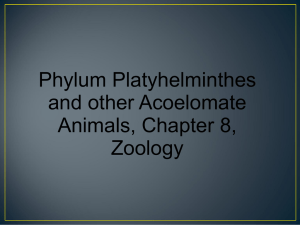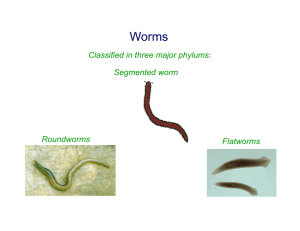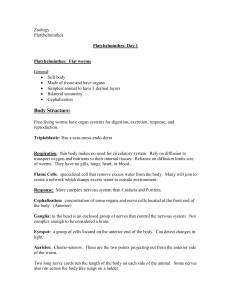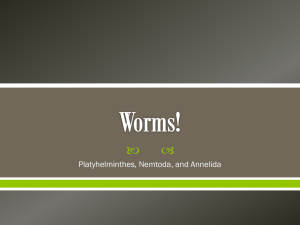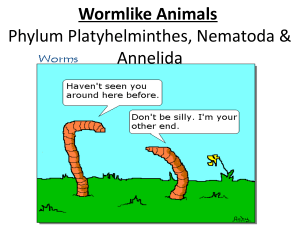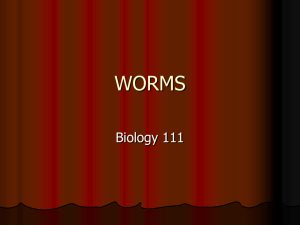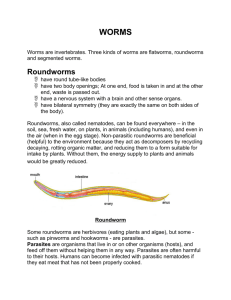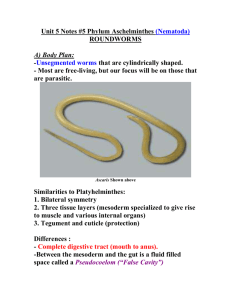Ribbon Worms
advertisement
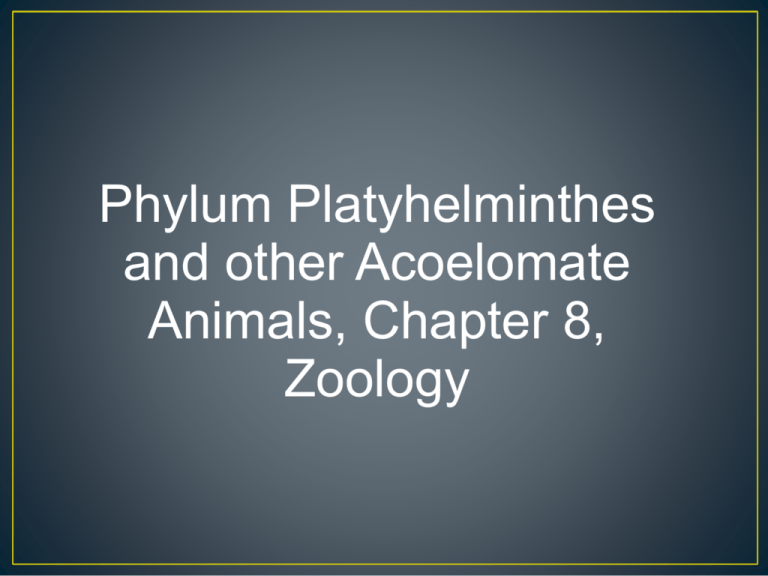
Phylum Platyhelminthes and other Acoelomate Animals, Chapter 8, Zoology Three germ layers (triploblastic), first animal discussed in this class with true organs and tissues. Bilateral symmetry and cephalization. Acoelomate, which means the spaces between the organs are filled with mesoderm tissue called parenchyma. Nervous system consists of a pair of anterior organs called ganglia that are basically a simple brain. Excretory system consists of two lateral canals connected to structures called flame cells No circulatory or respiratory organs; respiration occurs by diffusion. Many flatworms like the turbellarians are free-living organisms that dwell on the bottom of the ocean or freshwater habitats or moist places on land. All of the flatworms that belong to class Trematoda, Monogenea, and Cestoda are parasitic. Some are ectoparasites and others are endoparasites. Many have complex lifestyles that involve more than one host. The first host is usually an invertebrate and the second host is usually a vertebrate. The digestive system of some flatworms is incomplete, having only one opening that serves as a mouth and an anus. Turbellarians have a muscular mouth and pharynx that protrudes from the ventral surface. The pharynx is inserted into prey or decayed organic matter, digestive enzymes are secreted, and then the pharynx brings food into the gastrovascular cavity where it is digested. Digestion in tapeworms (cestodes) occurs by diffusion. The excretory system of flatworms consists of a complex network of cells called flame cells Flame cells (also known as protonephridia) are similar to kidneys in other organisms. The flame cells consist of a hollow cup filled with cilia that beat and pump water and nitrogenous wastes out the body. When the cilia of the flames cells beat they resemble flames. Flatworms are the first animal we have discussed that exhibits cephalization. Cephalization means they have a head (anterior) and tail (posterior) region. Cephalization allows animals to move (crawl, swim, fly etc.) in a certain direction to search for resources. In order to move in a specific direction the animal requires a central nervous system (brain, ganglia etc.). The central nervous system in flatworms is a region of nerve tissue found at the anterior end called a ganglion. The ganglion attaches to a pair of ventral nerve cords that run the full length of the body. The nerve cords are sensitive to touch, chemical detection, balance and equilibrium, water current direction and they can control muscular movement. The ganglion are also attached to eye spots that are sensitive to light. Reproduce both sexually and asexually. Sexual reproduction usually occurs by cross fertilization (trading sperm) with other hermaphrodites. Most flatworms are monoecious (both sexes in one animal). Only a few flatworms are dioecious (separate sexes). Asexual reproduction occurs by fission. The organism separates into two halves that regenerate into two adults. Free-living, soft flattened bodies Bodies are covered in cilia Mouth located on ventral surface near the center of the body Mostly hermaphroditic Some can reproduce asexually by fission Examples: Dugesia (planaria), Microstomum, Planocera Parasitic lifestyle with two hosts. First intermediate host is a mollusc. Second definitive host is a vertebrate. Sexual reproduction occurs in the definitive host. Occasionally a third intermediate host plays a role in the life cycle. Parasitism can occur in almost every system of the host’s body including the digestive, respiratory, circulatory, excretory, and reproductive systems. Examples: Fasciola, Clonorchis, Schistosoma A typical life cycle would include the following life cycle stages; adult, egg, miracidium, sporocyst, redia, cercaria, and metacercaria. Egg is released from host's excrement and must reach a source of water to be released. In the water the egg releases a free-swimming, ciliated larva called the miracidium The miracidium penetrates and enters the tissues of a mollusc (usually a snail), and transforms into a sporocyst. Sporocysts then reproduce asexually to produce redia. Redia reproduce asexually to produce cercaria. Cercaria emerge from the mollusc and penetrate a second intermediate host or they can develop as a metacercaria on vegetation. Metacercaria are ingested by a definitive host and develop into adult flukes. Some of the most serious parasites in humans are flukes. Genus Clonorchis is a liver fluke that is common in China, south Asia, and Japan and can cause cirrhosis of the liver and death. Genus Schistosoma is a blood fluke that causes an infection called schistosomiasis. Schistosomiasis is one of the deadliest diseases in the world with nearly 200 million people infected in Africa, South America, and the Middle East. Symptoms of severe dysentery, anemia, enlarged liver, inflammation of the bladder, and brain damage. One type of fluke that infects birds causes a painful irritation in humans called swimmer's itch. In the case of this fluke occurring in humans, the life cycle becomes terminated since the host in unsuitable. Children with Schistosomiasis Swimmer's itch Ectoparasites that attach to the gills of fish. Hook-like mouth called an opisthaptor. Occasionally they are found in frogs and turtles, but mostly on the skin or gills of fish. Common but cause little damage to their host. They can become a serious threat when fish become crowded, like in the case of fish farming. Life cycle simple with only a single host Examples: Dactylogyrus, Polystoma, Gyrodactylus Image on the right found on the gills of a fish Long flat bodies with a hook-like mouth called a scolex used for attachment to the wall of the intestine of its host. The rest of the body is followed by regular repeating units of reproducing sections called proglottids. The main body of a tapeworm is a chain of proglottids called a strobila. No digestive tract. Nutrients are absorbed across the skin by diffusion. All tapeworms require at least two hosts. Adults are parasitic in the digestive tract of vertebrates. Often one of the intermediate hosts is an invertebrate. Almost ALL vertebrate species can become infected, but adult tapeworms do little harm to their hosts. Humans most often get infected by consuming raw or rare beef, pork, or fish. Children often become infected by putting their fingers in their mouth after touching infected animals. Occasionally larval cysts (called bladder worms) can develop in the brain leading to severe brain damage and death. Ribbon Worms and Jaw Worms are similar to Phylum Platyhelminthes in several ways, but have significant differences which place them in their own separate phylums. They are both acoelomate and bilaterally symmetrical. Ribbon worms have flame cells and ganglia. Some ribbon worms can regenerate like planarians. However, in ribbon worms, the digestive tract is complete with both a mouth and an anus. Ribbon worms also have a circulatory system Jaw worms are a newly discovered species and have yet to be properly classified. They somewhat resemble rotifers. Ribbon Worms Jaw Worms
